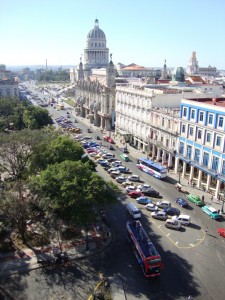
As the days get shorter and temperatures start dropping in Montana, my thoughts often turn to more tropical locations. This year, I already know where we are going, kind of. We’ll leave in April and head for somewhere between Hawaii and Australia. If you have the same inclinations and you’re looking for a place to visit this winter and need something closer to home, let me recommend a place that most Americans rarely consider: Cuba.
While Cuba offers its own vibrant culture and warmth, there’s something undeniably magical about Hawaii that calls to mind the ultimate tropical escape. Picture yourself walking along pristine beaches, the sound of waves gently lapping at the shore, and the scent of plumeria in the air.
Hawaii’s charm lies not just in its natural beauty but in the endless activities it offers, from adventurous hikes on volcanic terrain to tranquil afternoons spent snorkeling in crystal-clear waters. Booking guided tours can elevate your trip, letting you uncover the hidden gems of these islands without the stress of planning every detail yourself. Whether it’s a journey through lush rainforests or a sunset cruise along the Na Pali Coast, there’s a tour for every traveler’s dream.
If you’re a history buff, you can visit iconic landmarks like Pearl Harbor or take a guided tour of Oahu to uncover the rich heritage of the islands. For families, a boat ride along the Na Pali Coast or stargazing atop Mauna Kea creates magical moments everyone will cherish. No matter how you choose to explore, Hawaii’s beauty and aloha spirit have a way of making you forget the cold back home—and leave you dreaming of your next tropical escape.
After reading the November 2012 issue of National Geographic featuring Cuba, I’ve been thinking about the island more recently. Despite what you may have been led to believe your entire life,Cuba is actually a safe, interesting, inexpensive and fairly simple place to get to. People from all over the world – and lots of them — visit Cuba every year. The northern coast is thronged with all-inclusive resorts and airports that whisk tourists, mostly Canadians, but also Western Europeans, Scandinavians, Russians and South Americans (in seeming order of regularity) in and out of the country for a dose of sun. This post details some of the finer points of traveling in Cuba and is written mostly for another type of traveler – for the people who are interested in experiencing the non-resort parts of the island, or least giving it a try.
Getting to Cuba
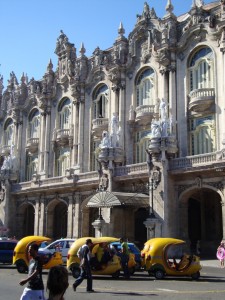
At present there are legit ways to get into Cuba, including via educational, religious and other activities. Check the US Department of State website for current regulations. But you can always do it the old fashioned way and just fly to Mexico. Usually, Cancun is easiest for hopping a flight to Havana, or you can travel through Canada. All of my research indicates that this is an extremely low priority for US Customs, that hundreds/thousand of Americans do it every year, and that they very rarely prosecute anyone, if they actually get caught, which is unlikely. Tickets from Cancun to Havana can be bought in advance through travel companies in Canada. There are also direct flights from Canada to many different cities in Cuba. If you’re in Montana, you could make your way to Calgary and fly directly to half a dozen Cuban cities. Plenty of cheap flights also go from Vancouver and Calgary. Don’t expect a new plane on Cubana Air, though. You’ll likely be treated to a 50-year-old Russian-style jet with signs in Spanish and Russian. If you fly through Mexico or Canada, they won’t stamp your passport in Cuba: you will pass through Cuban customs and be given a stamped piece of paper to keep in your passport. Don’t lose the paper. You will be asked for it often — Cuba likes to know where you are.
Money
One of the first things people usually want to know about Cuba is whether to bring cash, credit or some other form of currency. But first the basics: Cuba has two systems of currency. The first is the Cuban Peso, which is, officially at least, reserved for the Cuban populace. It is the currency Cubans use to buy bread, ride the bus, and generally go about their daily lives. The second is the Convertible Peso or CUC$ (pronounced as “kooks”). The CUC$ is the tourist dollar, and it is basically set at a 1:1 exchange rate with the US dollar. If you are a tourist in Cuba, almost everything you buy or pay for will be in CUC$, with a few exceptions if you are an experienced and adventurous traveler. Cubans also use the CUC$ to buy more expensive items, like washer and dryers, furniture, etc. American dollars used to be an accepted form of currency in Cuba, but that ended in 2004 with the introduction of the CUC$.
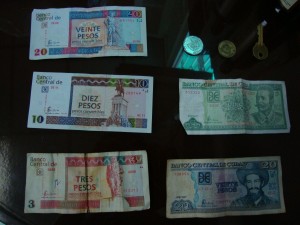
As an American, you have a few options for maintaining cash flow in Cuba: 1) you can bring all your money in US dollars and exchange your money for CUC$; 2) you can bring travelers checks (double check on this); 3) you can get a travel debit/credit card from another country (US credit cards and ATM cards will not work in Cuba). If you bring cash or travelers checks, you will pay a heavy exchange fee – around 20% — and, of course, you will be carrying around a lot of money and risk losing it or getting it taken from you. Many Americans we know have chosen to go a different route, by getting a short- term bank card from another country.
One very reasonable option, at least recently, has been to use Caribbean Transfers (www.caribbeantransfers.com). Here is the basic process: you email or call the CT office and set up your preferred amount of money and time of transfer. Next, you then wire the money to the CT office. Then, you show up in the Havana airport with a card waiting for you that will work in just about any bank throughout the country. Never mind that the card will probably be waiting for you in an unmarked booth, and you might have to find the airport janitor to get the key. If this sounds scary, it is. But Cuba is a land of contradictions and where, ultimately, and sometimes in mysterious way, things do work, usually on time and in order (you just won’t know what’s going on in the meantime). If you’re still not convinced about wiring money, think about this: Cuban migrants send about $2 billion per year back to their friends and relatives in country – they have figured out a system to do this. Or just carry around a big wad of cash and be paranoid the whole time….
Places to Stay

If I were going to Cuba, I would stay in Casas Particulares without a doubt. These are private Cuban residences, marked by a blue anchor on the door or entrance, which host tourists in one or two rooms that have been officially sanctioned by Cuban authorities. Its very similar to a bed and breakfast, and for $15-25 CUC$ you can get a private room in a Cuban household. If you’re traveling with a spouse or partner, consider yourself lucky because the room price is usually fixed regardless of whether one or two people are staying for the night. Meals are usually extra (more on that later). Amenities can vary widely depending on time and place, but you may find yourself in a room with 10 foot ceilings and ceiling fans that opens out into a Spanish hacienda style courtyard with fruit trees and fountains, or you may find yourself in a Havana apartment where they park the car in the living room for the night and you have a room in a highrise overlooking the city. These are legit operations — the rooms are by and large very clean and respectable. The families that rent the rooms are extremely friendly, and willing to help you, teach you, feed you, and talk to you. The government, always watching, is very aware of who is staying at the Casas Particulares (families have to report to local authorities) and how they are treating visitors. Plus, Cubans pay a monthly fee of $400 CUC to the government for the right to rent out these rooms – they have a good reason to treat people well and keep people coming back.
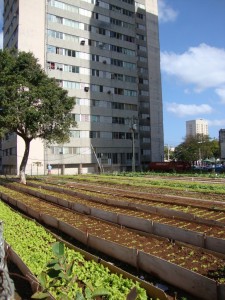
This is the way to see Cuba. You can stay in hotels if you want, but they are much more expensive. But more than cheap, the Casas Particulares get you in the center of the action, and in Cuba there is always some kind of action — friends are stopping by, someone is playing music, and people are living. These Cubans will be your tour guides, your night watch, help desk, and information centers. If you need recommendations in advance, let me know, but it’s super easy to get around Cuba without any advance planning. Just ask your host family for a recommendation in the next place you’re visiting, and you will hear the fours words that sum up Cuban culture: “I have a friend…” (Note that this will probably cost you a small $3 to 5 finders fee, but it will just be tacked on to your next room rental and you’ll probably never even know about it.)
Food
The food in Cuba is pretty easy to sum up: its not very good. This is probably one of the only drawbacks and likely one of the major misconceptions about the country. Cuban food is not the spicy, eclectic, seafood dish you ate at the Cuban fusion place in Miami last time you were there. Cuban food is ham and cheese sandwiches or rice with vegetables and chicken. That said, there are exceptions to the rule, and there are some ways to make your eating experience interesting and rewarding. There are basically four options:
Restaurants – Almost all of the restaurants in Cuba are run by the government, like everything else. These places will have different names, different décor and slightly different menus. But they’re basically the same. Try to avoid them when you can, though sometimes this will be the only option. The food is not good and the service usually stinks.
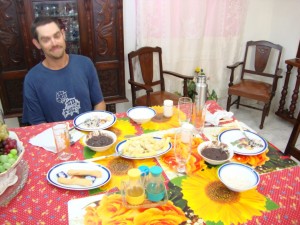
Paladares – Paladares are eating establishments in people’s private homes. They have been licensed by Cuban officials to sell food and look more or less like a restaurant. The good Paladares can be pretty crowded, for a good reason. The food is usually quite good and the service friendly. Some of these establishments can be hard to find and can be on the pricier side, but worth it.
Casas Particulares – As I mentioned previously, you can eat breakfast and dinner in the Casas Particulares for an extra fee. Breakfast will include fruit and juice, bread, eggs and some other treat. Dinner could include fish, shrimp, chicken or pork and then typically rice, bread, and vegetables. The meals are usually freshly prepared and served in good portions. You also get a chance to chat with family members and enjoy the surroundings. Breakfast usually runs about 4-5 CUC$ and dinner 7-8 CUC$.
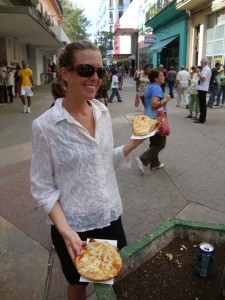
Street food – Where else can you buy a personal pizza for forty cents or a small breakfast sandwich for a quarter? The list goes on and on: ice cream for ten cents, coffee for a nickel…. Street food is the essence of the Cuban experience: it’s fast, ubiquitous, cheap and you have to wait in line for it. Lines at pizza windows can reach dozens deep around lunchtime, and there seems to be a national obsession with ice cream (going to the national ice cream chain, Coppelia, is like going to a circus or sporting event). Most street food options will include a piece bread (think dinner roll) with sometime inside of it. The filling could be tortilla (egg), pasta (a kind of semi spicy paste), mayonesa (you guessed it) or hamerguesa (yep). It some coastal cities you can buy sandwiches with fried fish or shrimp in it, which is delightful. Other street food fare includes cake, juice and of course, pizza – which is basically just tomato sauce and some cheese on pizza dough.
Transportation
Ok, now you had found a place to stay, gotten something to eat and you’re looking to move on. There are a few ways to tackle this next step.
Buses — Tourists generally take the Viazul bus line, which travels the well-trod routes between cities. You can buy tickets in advance at the Viazul bus depots or ask your host family to help, which they’ll probably be happy to do (for a small fee of course) The buses are modern, clean, generally on time and not terribly expensive. For some reason though, they blast the AC, and the buses can be extremely COLD. Be prepared. There are also local and regional bus lines that the Cubans ride. These are not really for tourists, but they’re much less expensive and have more options in terms of time and locations. If you speak Spanish pretty well and are willing to try to navigate this system, you might be able to utilize this option.
Taxis — Like everything else in Cuba, there is one system for tourists and one for locals. Tourist taxis are yellow, modern vehicles (Puegeot and Toyotae) with meters or set prices. Then there are the taxis for locals, which are the much photographed, older American vehicles (Fords and Chevys) that have probably been retrofitted with Korean or Japanese engines. You can ride in these taxis for a cheaper rate, but be discrete. These Cuban taxi drivers will be running a risk by taking you for a fare. They may even ask to drop you off around the corner from your destination, to try to stay low key. There are also bike taxis and coco taxis (literally a small, yellow coconut shaped pod) that can get you around in the major cities for a good rate.
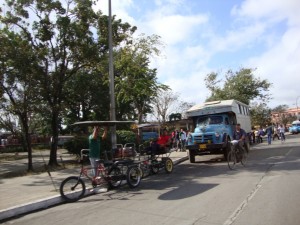
Cars — Renting a car in Cuba is actually pretty straightforward. All of the car rental companies are state run, so you can generally rent for one way trips and the prices don’t fluctuate too much (their comparable to US prices). Driving is a different story. Roads in Cuba can be unmarked and their condition can change dramatically. Large potholes appear suddenly, as do cows, donkey carts, people, etc. Other vehicles may not have their lights on, either because they don’t work or because they don’t want to use them, and driving in cities can be confusing with roundabouts, one way streets, and other problems that are only avoided through local knowledge. It’s a great way to see the country, but be wary.
Hitchhike — You’ll see Cubans all over the roads looking for a ride, so learn how to compete. On a sidenote, picking up hitchhikers can help you navigate driving local streets if you end up renting a car.
Culture
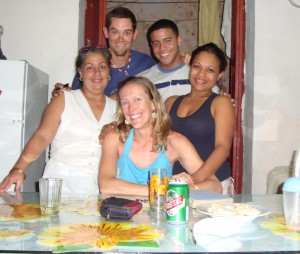
Cuba is by far one of the most fascinating, welcoming and confusing places in the world. Stuck in a bastion of socialism, Cubans are some of the most capitalistic people you have ever met, because they have to be to survive. Whether it’s a small black market business, a tourist-oriented enterprise, or some scam with a family member overseas, Cubans are extremely entrepreneurial. Most Cubans have state jobs (although Cuba, in the midst of some economic problems, recently cut nearly a half million state employee positions). State jobs are low paying and not very fulfilling. That’s why many of the uniformed workers you will encounter are aloof and not very helpful. But get rid of the uniforms and Cubans are lively, friendly, and entertaining people. On the homefront, they will kiss you on both cheeks upon greeting, even if they’ve never met you before, and they speak Spanish rapidly, like they’re talking during a marble-eating contest.
Cubans are also very neat, well dressed people who follow the most recent music, fashion and media culture come out of the US. They like bright colors (yellow, red and white outfits seem in vogue recently) and have no problem with public displays of affection – with strangers, friends or loved ones. They also hate waiting in lines — probably because they do it all the time — and have developed some elaborate line protocols. If you need to get in line, just ask: “Quien es ultimo (Who is last)?”. You’ve then reserved your space in line, and you don’t really even need to stand there. People will just linger about until its their turn.
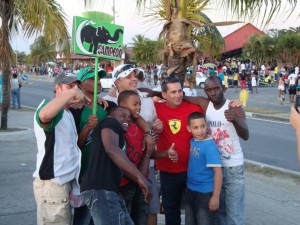
By and large, they also love Americans because, well, we’re not Canadians, which visit in hoards. Seriously, Cubans identify with the United States. The island is only 90 miles from Florida and everyone in Cuba, and I mean everyone, has an uncle, brother, niece or grandmother who live in Miami, or possibly California. They treat Americans with warmth and mutual respect, as they do most people. They like to practice English, make new friends, and foster a good reputation for their country and people.
Give Cuba a try. It won’t be the most straightforward to make travel arrangements, and it will take some effort to figure out the system once you’re there, but I’ll guarantee this: it will be unlike any place you’ve ever been and well worth any complications.
(Full disclosure: Cuba can be a very confusing place and relations with the US are ever changing, so any of the above information could change at any time. And I’ve certainly never been there…).

2 thoughts on “How to Travel In and Around Cuba”
Very informative and interesting!
I even have an idea for construction of a new facility to
replace that evil place known as Gitmo (this is very important because we don’t want to
create a bad impression in the minds of our
fellow members in the United Nations). This was
exactly in the 6th day of august, in 1990; which marked the fourth day after their Iraqi invasion of Kuwait.
It is a fact that 10 billion farmed animals die each year to become meat products for the American public.
Excellent way of telling, and fastidious
paragraph to get facts on the topic of my presentation focus, which i am going to deliver in academy.